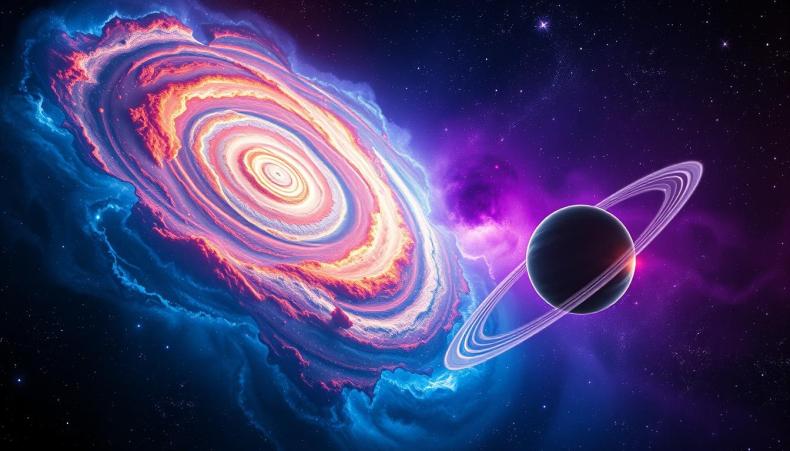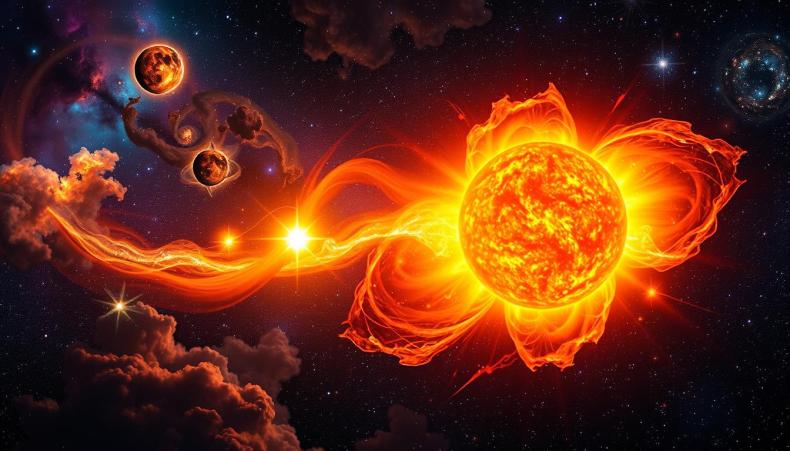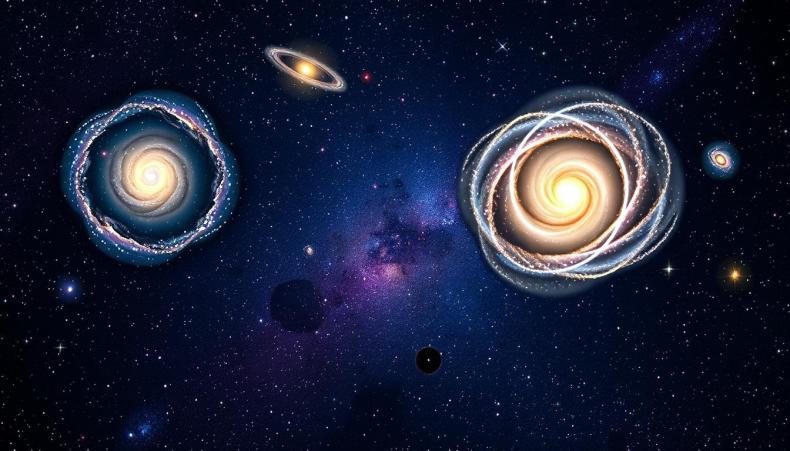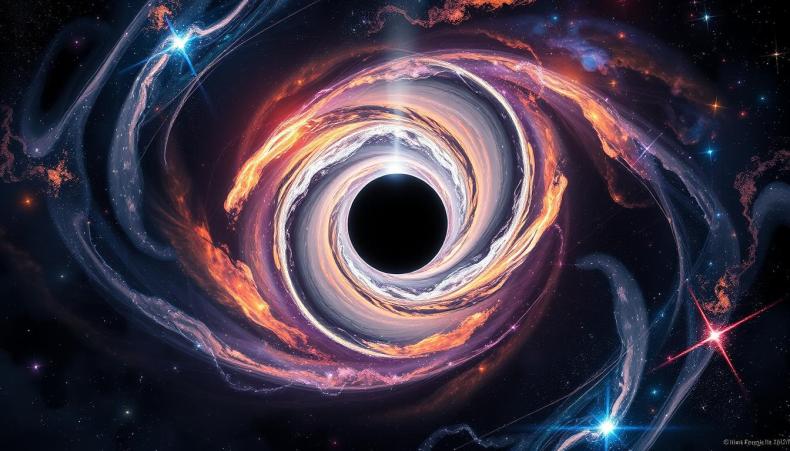Astrophysics is a branch of space science that studies the physical properties of stars and galaxies. It combines physics and astronomy to explore the universe. This article aims to make astrophysics easy to understand, covering topics like stars, galaxies, and dark matter.

Key Takeaways
- Astrophysics merges physics and astronomy to understand celestial bodies.
- Key concepts include gravity, time, light, and energy.
- The birth and death of stars play a crucial role in the universe’s lifecycle.
- Galaxies are the foundational structures that form the cosmos.
- Black holes present intriguing mysteries with significant implications for space-time.
- Dark matter and dark energy are essential to uncovering the universe’s fate.
- Astrophysics contributes to advancements in technology and our understanding of the universe.
What is Astrophysics?
In my journey through the cosmos, I always seek to understand the definition of astrophysics. This field studies the universe’s physical properties and the rules that govern it. Topics include star lifecycles, galaxy formation, cosmic radiation, and black holes.
An astrophysics overview shows how it combines physics and astronomy. Famous figures like Carl Sagan and Neil deGrasse Tyson have made these ideas easy to understand. They’ve helped many people learn about the universe.
Astrophysics has many branches, each looking at different parts of the universe. These branches explore everything from tiny particles to galaxy connections. For those who love the mysteries of space, exploring these branches is exciting.
Through cosmic studies, we learn about the universe and our place in it. Astrophysics is more than just studying; it’s a quest to understand existence itself.
Key Concepts in Astrophysics
Gravity is key in astrophysics. It affects planets’ orbits and galaxy formation. Newton’s law and Einstein’s theory help us understand gravity’s role.
Gravity and Its Role
Gravity pulls massive objects towards each other. It shapes our universe. Gravity makes planets orbit stars and galaxies collide.
It also warps space-time around black holes. Studying gravity helps us understand time dilation and light bending.
Time and Space
Einstein’s space-time concept is crucial. It shows time can stretch and compress. This impacts astrophysics, especially black holes and the universe’s expansion.
Space-time and relativity change how we see the universe. They help us understand cosmic events and the universe’s history.

| Concept | Description |
|---|---|
| Gravity | The force attracting two bodies towards each other, essential in understanding celestial movements. |
| Roles of Gravity | Determines the structure and dynamics of galaxies, star clusters, and planetary systems. |
| Gravitational Forces | The interactions between masses that dictate their positions and behaviors in space. |
| Space-Time | A four-dimensional continuum combining the three dimensions of space with the dimension of time. |
| Relativity | The theory explaining how time and space are interrelated, influenced by the presence of mass. |
| Time Dilation | The phenomenon where time passes at different rates depending on velocity and gravitational influence. |
Fundamentals of Astrophysics
In my journey through astrophysics, I’ve learned that light and energy, and mass and matter, are key. These basics help us understand the universe. They light up the cosmos for us.
Understanding Light and Energy
Light is crucial for seeing the stars and planets. The electromagnetic spectrum shows us all kinds of light, from radio waves to gamma rays. Each type tells us something different about space.
Infrared light helps us see cool objects like dust clouds. X-rays, on the other hand, show us hot, high-energy things like black holes. Knowing how light works with matter is key to understanding the stars.
Mass and Matter in the Universe
In astrophysics, mass is what pulls things together. There’s visible matter in stars and galaxies, and then there’s dark matter. We can’t see dark matter, but we know it’s there because of how it pulls on things.
Looking at mass in astrophysics and energy, we get a big idea. Einstein’s famous equation, E=mc², shows how energy and matter are connected. This shows us how the universe works in a big way.
| Type of Light | Wavelength Range | Applications in Astrophysics |
|---|---|---|
| Radio Waves | 1 mm – 100 km | Studying cold objects and cosmic microwave background |
| Visible Light | 400 nm – 700 nm | Observing stars, planets, and galaxies |
| Infrared | 700 nm – 1 mm | Examining dust clouds and cooler celestial bodies |
| X-rays | 0.01 nm – 10 nm | Investigating high-energy phenomena like black holes |
| Gamma Rays | Less than 0.01 nm | Studying violent astrophysical events, such as supernovae |

The Birth and Death of Stars
Stars are amazing in the universe, starting with their birth. They form from huge clouds of gas and dust. These clouds collapse, creating protostars.
As energy grows, protostars become main-sequence stars, like our Sun. Here, nuclear fusion starts, making light and heat.
As stars get older, they use up their fuel. This is the start of stellar evolution. The star gets bigger, changes, and sheds layers.
The core gets smaller, and temperatures go up. This leads to the creation of heavier elements. When the star runs out of fuel, it dies.
Stars can die in different ways, based on their size. Small stars might lose their outer layers, leaving a white dwarf core. Big stars can explode in a supernova, becoming a neutron star or black hole.
These events end a star’s life but also help the universe. They recycle materials, helping new stars and planets form.

Galaxies: The Building Blocks of the Universe
Galaxies are amazing in the universe. They are huge groups of stars, gas, dust, and dark matter held together by gravity. Learning about galaxy types helps us understand how the universe began and changed. Each type, like spiral, elliptical, and irregular galaxies, has special features that tell our cosmic story.
Types of Galaxies
Exploring galaxy types is fascinating. They have different shapes and traits:
- Spiral galaxies: These galaxies have beautiful spiral arms. The Milky Way is a great example, with billions of stars and complex systems.
- Elliptical galaxies: These galaxies are round and simple. They have older stars and no spiral arms.
- Irregular galaxies: These galaxies don’t follow a pattern. Their shape changes due to interactions with other galaxies.
The Milky Way and Its Neighbors
The Milky Way is part of the Local Group, with galaxies like Andromeda nearby. Looking at these galaxies helps us understand how they interact and merge. It also tells us about our cosmic history.

| Galaxy Type | Characteristics | Example |
|---|---|---|
| Spiral | Distinct arms and active star formation. | Milky Way |
| Elliptical | Rounded shape with older stars and minimal star formation. | Messier 87 |
| Irregular | No defined structure; often result of interactions. | Large Magellanic Cloud |
By studying these galaxy types and how they interact, we learn more about our universe. It’s a complex and fascinating place.
The Expanding Universe
The idea of universe expansion is key in modern astrophysics. It started with Edwin Hubble’s work in the early 1900s. He found that far-off galaxies are moving away from us.
This supports the Big Bang theory. It says our universe began as a single, tiny point. And it has been growing ever since.

This cosmic evolution helps us learn about the universe’s past. By studying how fast galaxies move away, scientists can guess the universe’s age. They also figure out what’s making it expand.
This knowledge is huge. It changes how we see the universe’s history. It also tells us about the universe’s possible future.
- Expansion Rate: The speed of galaxies moving away.
- Cosmic Microwave Background: Evidence from the early universe.
- Dark Energy: The driving force behind the acceleration of expansion.
I find it amazing how each new discovery about universe expansion changes our view of the universe. It tells us about our origins and our possible future.
Black Holes: The Mysteries Within
Black holes are mysterious objects in our universe. They show us how stars can change in amazing ways. This helps us learn more about the universe.
How Black Holes Form
Black holes form after a massive star explodes. This explosion is called a supernova. The star’s core then collapses, creating a black hole if it’s heavy enough.
This collapse makes a space so strong that nothing, not even light, can get out. This is what makes black holes so special.
The Impact of Black Holes on Space-Time
Black holes change the space around them a lot. Their strong gravity pulls on nearby objects and light. This makes them change their paths.
The edge of a black hole is called the event horizon. Once you cross it, you can’t get out. This makes us wonder about space and time.

Dark Matter and Dark Energy
Dark matter and dark energy are key parts of modern astrophysics. Dark matter makes up almost 27% of the universe. Dark energy is about 68%. Dark matter can’t be seen, but it affects stars and galaxies through gravity.
Dark energy makes the universe expand faster. It’s a big mystery. It raises questions about the universe’s future and how it works.

| Component | Percentage of Universe | Key Characteristics |
|---|---|---|
| Dark Matter | 27% | Invisible, detected through gravitational effects on visible matter. |
| Dark Energy | 68% | Causes accelerated expansion, largely mysterious in nature. |
Studying dark matter and dark energy helps us understand the universe. It also makes us question what we know. I’m excited to learn more about how these forces shape the universe and what they mean for our future in astrophysics.
The Importance of Astrophysics in Everyday Life
Astrophysics might seem far from our daily lives. But it has a big impact on us. The practical applications of astrophysics are seen in many technologies we use every day. For example, GPS and modern phones work because of astrophysics.
In healthcare, new cancer treatments come from astrophysics research. This shows how studying the universe helps us live better. It’s a clear example of the impact on society.
Learning about astrophysics helps us understand science better. It makes us curious and encourages kids to study science and tech. This is key for new discoveries.

| Field | Technology Derived | Practical Application | Impact on Society |
|---|---|---|---|
| GPS | Satellite navigation | Maps and location services | Enhanced travel and logistics |
| Telecommunications | Signal processing | Mobile phones and internet | Global connectivity |
| Medical Technology | Cancer treatment | Radiation therapy techniques | Improved health outcomes |
| Environmental Monitoring | Remote sensing | Climate change studies | Informed policy decisions |
Conclusion
We’ve explored some amazing cosmic ideas in this summary of astrophysics. We’ve looked at how stars are born and die, and how the universe is growing. We’ve also talked about mysterious black holes.
Each topic shows how our world is connected in a big way. I wanted to make these ideas easy to understand. I hope you now see why knowing about the universe is so important.
The future of space study looks very promising. New technology will help us learn more about the universe. This makes us excited for what we might discover next.
Studying space not only helps us learn more. It also makes us think about our place in the world. It’s a journey that makes us appreciate our existence even more.
Exploring the universe through astrophysics is a journey worth taking. It’s not just about learning facts. It’s about understanding our connection to the stars and the vastness of space.
FAQ
What exactly is astrophysics?
Astrophysics is a science that studies the universe and its parts. It uses physics and astronomy to learn about stars, galaxies, and space.
How does gravity impact astrophysics?
Gravity is key in astrophysics. It helps us understand how things move in space. It’s important for studying galaxies and how the universe formed.
What are the different types of galaxies?
Galaxies are divided into spiral, elliptical, and irregular types. Each type helps us learn about the universe’s history and how galaxies change over time.
Can you explain the life cycle of a star?
A star’s life starts with gas and dust. It grows into a main-sequence star, like our Sun. As it ages, it can become a white dwarf, neutron star, or black hole.
What is the significance of dark matter and dark energy?
Dark matter and dark energy are vital for the universe’s structure. We can’t see dark matter, but its gravity is clear. Dark energy makes the universe expand faster.
How do black holes form, and why are they important?
Black holes come from massive stars that explode. Their gravity warps space and time. This makes them a big interest in astrophysics.
What are the practical applications of astrophysics in daily life?
Astrophysics helps create important technologies like GPS and cancer treatments. It makes science and technology exciting for everyone, inspiring the next generation.